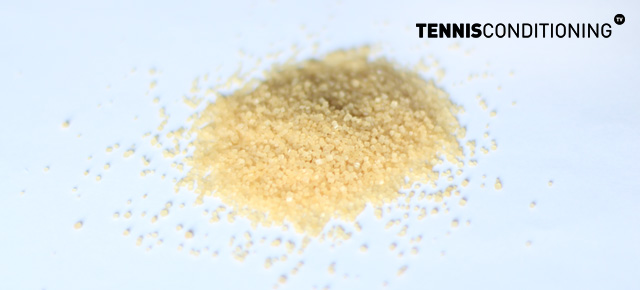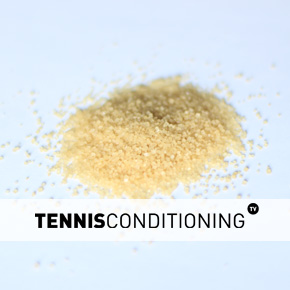Sugar increases fat storage when glycogen stores are full and carbohydrates are still available!
Don’t you wonder why you store fat even though you consume foods that are fat free (e.g. jelly beans)? So how can jelly beans, for instance, increase fat storage?
The answer is simple: excess carbohydrates provided by your diet are stored as fat.
Excess carbohydrates (glucose) that couldn’t be stored in the form of glycogen will be broken into smaller compounds in the liver.
The liver breaks down glucose in smaller molecules and puts them together in the form of fat.
Then the fat is being transported from the liver and stored in fatty tissues in the body.
The Role of Insulin

A complex carbohydrates (polysaccharide; starches & fibers) will travel through your entire gastrointestinal tract (GI; 15 feet) before they are fully absorbed but the simple sugars (monosaccharides & disaccharides) will be absorbed very early on (with the 1st foot).
So, simple sugars (e.g. white bread) will be absorbed quickly in the small intestine.
Whereas whole grains (complex carbohydrates) will take about 15 feet worth of traveling in the GI before they are fully absorbed and digested into the blood stream.
Therefore, the simple sugars will cause a rapid increase in blood insulin levels because blood glucose levels are high.
Insulin is released by BETA-cells in the pancreas in response to high blood glucose levels. Insulin actually moves glucose from the blood into tissue/cells (also into fat cells), thereby replenishing glycogen stores and reducing blood glucose levels.
In other words, glucose going into muscles is a good thing, helping restore muscle energy levels (glycogen) for muscular contraction. But glucose uptake into fat cells also occurs due to insulin.
When glucose enters fat cells, it can be turned into glycerol or fatty acids, which is why glucose is associates with high triglyceride (glycerol + 3 fatty acids) levels.
Once glucose turns into fat it cannot be converted into glucose again – it is going to stay fat until it is metabolized because of the one-way enzyme pyruvatedehydrogenase (PDH)!

The other effect insulin has is that it lowers fat utilization because insulin will prevent the oxidation of fatty acids by blocking fats from entering the mitochondria.
Therefore, insulin has the direct ability to prevent you from using fat for fuel.
This is where exercise comes into play. During exercise, insulin levels decrease so that you have the ability to use fat (deliver fat to mitochondria and “burn it” in the carbohydrate flame [aerobic glycolysis]) for fuel.
That’s the reason why insulin is suppressed during exercise! Chronic elevated insulin levels decrease cellular sensitivity/responsiveness and increase the risk for diabetes.
How?
When sugar enters fat cells it starts as a 6-carbon sugar but there are different enzymes along the way (e.g. hexocanase, pfk, aldolase, etc.) that split it into a glycerol-3-phosphate.
So, a fat cell can make glycerol and add 3 fatty acids and form a triglyceride or it can take pyruvate (enzyme that remove a hydrogen from pyruvate.
Pyruvatedehydrogenase [PDH]), remove a hydrogen from it, and get acetyl CoA (2-carbon; acetyl groups added on to each other become acidic acids, which are fatty acids).
Therefore, the body can turn sugar into fat directly!
The thing about the enzyme pyruvatedehydrogenase (PDH) is that insulin will activate it and increase it (one way enzyme). Hence, once sugar turns into fat it cannot be reversed back into glucose (sugar).
So, once sugar is turned into fat it stays fat until it is metabolized by the body. Insulin also promotes another enzyme, FAS (fatty-acid synthase), thereby promoting fat storage.
From a triglyceride the body can either make (in the liver) glycerol or fatty acids but no glucose.
Atkins Diet Uses Same Mechanism
This is the same principle the Atkins diet runs on – by lowering simple carbohydrate intake, individuals also lower blood triglyceride levels by lowering insulin levels, decreasing fat storage.
When you take a closer look at pre-diabetics, they have elevated insulin levels (hyperinsulania) which promotes more fat storage and it spirals out of control.
For this reason people suffering from metabolic disease (e.g. pre-diabetics), experiencing high levels of insulin (hyperinsulania), benefit using the Atkins diet.
FYI – For Your Information

Consuming 1 soda (not diet soda) per day translates into consuming 32.5 lbs of sugar annually!
Related Articles
Training Zone
In this section we provide you with some more workouts and training tips you may be interested in to optimize your training:




